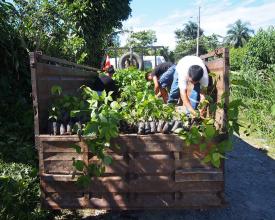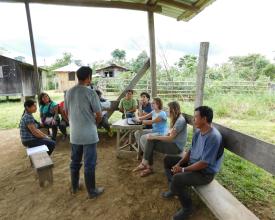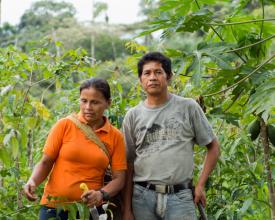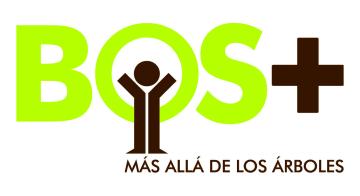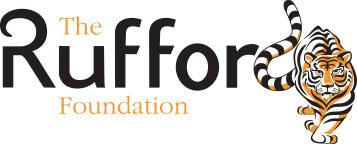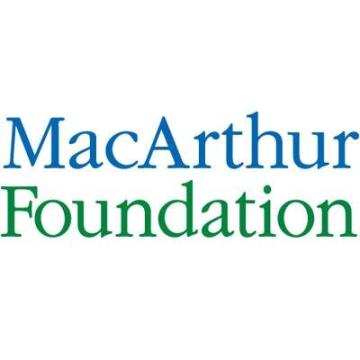
Runa Foundation Farming for Biodiversity

Building on local knowledge, Runa provides training to indigenous farmers to mitigate the effects of climate change, foster biodiversity, and improve livelihoods by creating new value for forest products and increasing access to markets and economic stability.
Runa supports farmers with capacity-building workshops to create platforms for collective decision-making and management. These initiatives empower local communities to manage their own resources, improve their livelihoods, gain access to credit, restore biodiversity, and protect cultural traditions tied to their agroforestry systems. One example of this is the marketing of the leaves of Ilex guayusa (a tree native to the western Amazon) which are consumed for centuries by the indigenous people of the Ecuadorian Amazon. Guayusa is known for its energetic properties due to its high concentration of caffeine and antioxidants.
Contexto
Défis à relever
Traditionally, indigenous farmers in the Amazon have maintained ‘chakra’ agroforestry systems that mimic the forest’s natural composition, providing subsistence crops to families and natural habitats for flora and fauna.
In search of additional income, farmers are increasingly pressured to abandon the chakra farming method, resorting to conventional production of commercial crops, cattle grazing, and timber extraction. These activities often encroach on protected areas, threatening many species and contributing to deforestation and degradation. From 1990 and 2010 alone Ecuador lost a total of 28.6% of its forest cover.
Additionally, infrastructure development in the region through increased government programs and population growth has led to deforestation and exploitation in previously isolated areas. This has led to forest fragmentation, creating small pockets of biodiversity that limit the movement of fauna and create regions that are more susceptible to human impact.
Ubicación
Procesar
Summary of the process
Our foundational building blocks of creating sustainable value chains based in local biodiversity (BB 2) and strengthening farmer associations (BB 1) interact with each other to create local capacity for designing strategies that are based in local realities, that protect ecosystems, and that improve livelihoods. When working with local farmer associations to create new value chains, it is essential that the association has the capacity to manage their productive activities and develop into a self-sufficient entity. It is important that all actors see the viability and benefits of the work and feel capable of fulfilling their roles and responsibilities. We work directly with farmers and their leaders to strengthen their organization through workshops, knowledge exchanges, and technical assistance to improve the capacity of the association itself so that they can effectively manage their participation in the value chain. Through these activities and direct collaboration with a variety of local actors, we can create viable value chains based on local knowledge and the demands of international markets.
Building Blocks
Strengthening Farmer Associations
Runa Foundation’s strategy for community development is to create strong community-based organizations and associations that can invest money and resources into their own development to improve livelihoods. Over the past 3 years, there has been a great deal of organizational advancement among the guayusa producer associations. Unlike other parts of Latin America, there is not a strong history of agricultural cooperatives in the Ecuadorian Amazon. Given this context, we prioritized Fair Trade Certification and strengthening farmer’s capacity for organization and resource management, in order to ensure that indigenous producers are able to connect with markets in a way that is just and equitable. One of the main components of success in establishing producer associations has been to mimic the functioning of current governance structures that are used locally to manage communities, land, or resources. Instead of imposing a structure that has worked successfully in other parts of Latin America, producers determine the structure and function of their associations, and we work with them to build a governance system that is efficient and legitimate in the eyes of producers.
Enabling factors
The advancement of associations can in part be attributed to the participation and buy-in from local actors, which creates and defines a work structure for planning, coordination, and monitors the progress of the associations. A structure that is flexible and able to adapt to the needs of individual associations is essential. This often requires investing more time and resources to have additional meetings or workshops to ensure that the associations are building capacity to advance in a sustainable way.
Lesson learned
It is sometimes difficult to motivate associations to participate in the many activities required for the certification of their product. For established crops such as coffee and cacao, the anticipated purchase volumes, higher prices, and established markets for certified products help to ensure that sales and the social premium contribution from their Fair Trade certification act as a sufficient incentive. However, as a novel product, the lack of market stability jeopardizes continued and quality participation of producers and associations. We have also learned the importance of creating mechanisms for collaboration among all stakeholders involved in the value chain and establishing clear guidelines to lead our work. Over several years we have been collaborating directly with the associations as well as private- and public-sector actors and analyzing and revising the different activities involved in the guayusa value chain utilizing an adaptive management approach that has been highly successful for this collaborative work.
Building Sustainable Value Chains Based In Local Biodiversity
Runa works to build sustainable value chains for innovative products based in local biodiversity. Runa focuses on products that are emblematic of local culture and have a history of use and sustainable production among the indigenous communities we work with. Runa supports local producers to access a variety of market opportunities that balance value-added activities, stable market access, and the ability to sell any excess production locally. Runa works with communities to create spaces for smallholder farmers to turn traditional productive systems into sustainable livelihood opportunities.
Enabling factors
Runa’s success in developing sustainable value chains can be attributed to collaboration with locals to utilize their vast knowledge of agricultural and non-timber forest products and production techniques and the existing demand in international markets for novel and exotic products. Though new value chains require investments of time and resources, Runa has been able to provide financial and capacity building support and assume risks that otherwise might incur to farmers and impede their participation or the success of the project.
Lesson learned
In order to create sustainable value chains based in biodiversity, Runa recognizes the importance of working directly with producers to develop strategies and formalize best practices for small holder farmers. Our analysis shows that in the beginning years of market development for a new crop, it is unlikely that market forces alone will be able to incentivize ecological and socially sustainable production, especially as dictated by the Fair Trade and USDA organic standards. Additional support is necessary to cover the costs required to achieve social and ecological impacts while economic sustainability develops. We have also learned that high demand and stable prices are necessary for farmers to invest in adopting new management practices to improve production. A farmer’s access to a stable market and confidence that they will be able to sell their crop makes them more likely to take the risk of experimenting with new techniques without the fear of economic loss from an income generating activity.
Impacts
Runa Foundation supports biodiversity and positively impacts the local environment in three principal ways.
1) Creating viable economic opportunities for non-timber forest products and organic agroforestry products increases overall income, reducing the necessity for unsustainable agricultural activities. Our efforts to increase sustainable production in buffer zones leverages impact to reduce encroachment into protected areas.
2) Runa promotes the production of Ilex guayusa in mixed-use agroforestry systems, which are more biodiverse than conventional agricultural systems. A study investigating diversity and productivity of mixed agroforestry systems found that polycultures improve crop resilience against environmental pressures by increasing ecological diversification and decreasing land degradation through the natural cycling of nutrients and reduced human disturbance. The proliferation of these systems supports the maintenance of local flora and fauna populations, as these systems mimic the natural forest composition.
3) Supplementing our agricultural initiatives, our program works with communities to create integrated landscape plans that include strategies for improved resource management, as well as reforestation and restoration. This program has incorporated over 56,000 hectares into sustainable management plans, with 150 hectares of planned reforestation and restoration.
Beneficiaries
The beneficiaries of this initiative are indigenous kichwa farmers in the Ecuadorian amazon. Through this initiative, new value is being created for forest products that is environmentally sustainable and will improve livelihoods for local farmers.
Sustainable Development Goals
Story
Maira Pisango is president of the producer association UCKAR, and lives in the Kichwa community of San Rafael. She has worked with Runa Foundation since 2010, and was elected president of the guayusa producers in her area. She facilitates the management and investment of the Social Premium Fund, generated from the sale of Fair Trade certified guayusa. Her first major accomplishment was to buy farm supplies for the members of her association, and she is currently working to obtain legal standing for her association. As a female leader, Maira is a role model and pioneer in her community. She excels at managing the needs of her constituents, and is also known for her warmth and openness. Becoming a leader has changed her status in the community; she now travels, leads meetings, and relishes in her role as a public figure. “Before [becoming a leader] I stayed in the house, I was scared, I was intimidated to speak in front of a group, to answer questions.” The opportunity to take on a leadership role has transformed many aspects of her life. Maira grew up in a situation common to many rural Kichwa women. As one of 12 children and a girl, her parents were unable to provide for her. Like many women of her generation, she did not advance beyond an 8th grade education by the time she married. But with her husband’s support, she was able to finish high school while raising her first two children. When she expressed interest in becoming a leader, her husband tried to stop her, he didn’t want her to work to interfere with her household responsibilities. However, he changed his mind after seeing how much she gained from her role. She proudly states, “I am now an example to my children.” Her husband works on construction sites, and when he is between jobs, she takes him with her to meetings and trainings. In previous jobs she mentioned having faced racism and exploitation, as many Kichwa women do. In contrast, her work with Runa has been both professionally and personally fulfilling and has given her access to the professional world which is a rare opportunity for women from rural areas with low levels of education. Maira consistently stresses the importance of education which is the main expenditure of the household. The trainings involved in being a leader have helped her continue her own education and learn valuable skills. Maira is eager to continue working and to help producers gain access to new markets for the sale of their guayusa.
